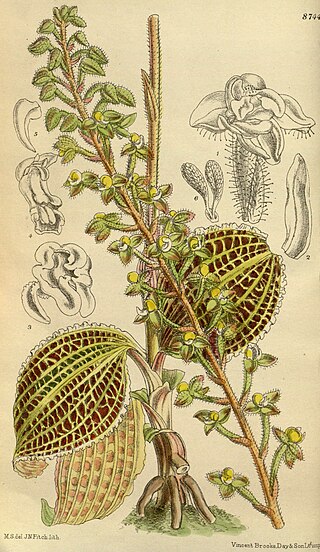
Orchids are plants that belong to the family Orchidaceae, a diverse and widespread group of flowering plants with blooms that are often colourful and fragrant.

Dactylorhiza fuchsii, the common spotted orchid, is a species of flowering plant in the orchid family Orchidaceae.
Stink bug or stinkbug is a common name for several insects and may refer to:
Bee orchid is a common name for several orchids and may refer to:
Jewel box or Jewel Box may refer to:

Anoectochilus, commonly known as marbled jewel orchids or filigree orchids, is a genus of about fifty species in the orchid family Orchidaceae. They are terrestrial herbs with a creeping rhizome, an upright flowering stem and dark coloured leaves with contrasting veins. The flowers are relatively large and have a large labellum, markedly different from the sepals and petals.
Ghost plant is a common name for several plants and may refer to:
Spider orchid typically refers to the orchid genus Caladenia as a whole.
Tongue orchid or tongue-orchid is a common name for several plants and may refer to:
Butterfly orchid is a common name for several orchids and may refer to:
Anoectochilus sandvicensis, also called Hawaii jewel-orchid, is a species of plant in the family Orchidaceae. It is endemic to Hawaii. It is threatened by habitat loss. It is found in the Haleakala National Park. It grows in dense, dark, and continuously saturated forest. A. sandvicensis is a perennial herb which grows up to 20 in (51 cm) tall.
Ghost orchid, is a common name for several orchids, and may refer to:

Ludisia (Lus.) is a genus of orchids that was thought to contain just one species, Ludisia discolor, commonly referred to as jewel orchid. A second species, Ludisia ravanii, from the Philippines, was described in 2013. Ludisia discolor is native to Southern China, Northeast India, Thailand, Vietnam, the Philippines, Malaysia, Indonesia and Myanmar, and often cultivated.
Bog orchid is a common name for several orchids and may refer to:

Goodyerinae is an orchid subtribe in the tribe Cranichideae.
Giant orchid is a common name for several plants and may refer to:
A. flavescens may refer to:

Anoectochilus yatesiae, commonly known as the marbled jewel orchid, is a species of orchid that is endemic to northern Queensland. It has up to six dark green leaves with a network of silvery veins and up to four hairy brownish and white flowers.

Macodes sanderiana(Kraenzl.) Rolfe is a species of South East Asian jewel orchid mostly recorded from New Guinea but is also found in the Solomon Islands and Vanuatu. This species has a long history of cultivation in Europe since the early 20th century and is prized for its ornamental leaves which are the largest in its genus. The leaves are dark green, the upper surface covered in an intricate network of veins in colors ranging from bright green to copper. In contrast, flowers are small and pallid so are often removed in cultivation. In nature, M. sanderiana grows in rainforests on the forest floor or lithophytically out of rock crevices. This species survives at a broad range of altitudes from close to sea-level, up to the lower boundary of the cloud forest. Exudates from the leaves of this orchid are traditionally used in New Guinea as eye drops for the treatment of myopia. M. sanderiana has not been assessed for the IUCN red list, however, as recently as the 1980’s this species was common in parts of its range within New Guinea.
This page is based on this
Wikipedia article Text is available under the
CC BY-SA 4.0 license; additional terms may apply.
Images, videos and audio are available under their respective licenses.






